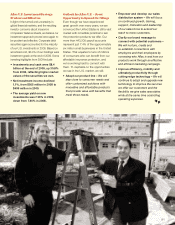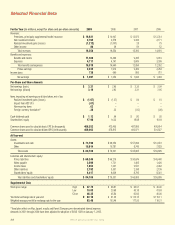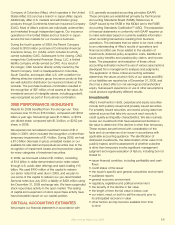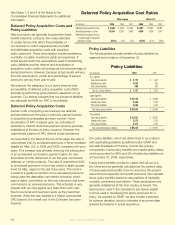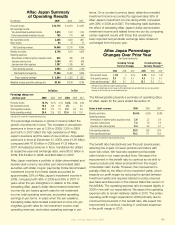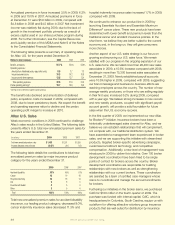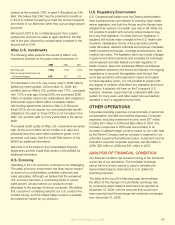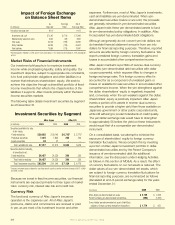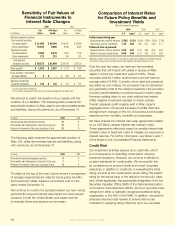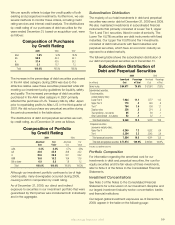Aflac 2009 Annual Report Download - page 34
Download and view the complete annual report
Please find page 34 of the 2009 Aflac annual report below. You can navigate through the pages in the report by either clicking on the pages listed below, or by using the keyword search tool below to find specific information within the annual report.
primarily to the settlement of an examination by the Internal
Revenue Service that reduced the ASC 740 tax liability by
$24 million. Total income taxes were $738 million in 2009,
compared with $660 million in 2008 and $865 million in
2007. Japanese income taxes on Aac Japan’s results
account for most of our consolidated income tax expense.
See Note 8 of the Notes to the Consolidated Financial
Statements for additional information.
Earnings Guidance
We communicate earnings guidance in this report based
on the growth in net earnings per diluted share. However,
certain items that cannot be predicted or that are outside
of management’s control may have a signicant impact on
actual results. Therefore, our comparison of net earnings
includes certain assumptions to reect the limitations that
are inherent in projections of net earnings. In comparing
period-over-period results, we exclude the effect of realized
investment gains and losses, the impact from ASC 815 and
nonrecurring items. We also assume no impact from foreign
currency translation on the Aac Japan segment and the
Parent Company’s yen-denominated interest expense for a
given year in relation to the prior year.
Subject to the preceding assumptions, our objective for
2009 was to increase net earnings per diluted share by
13% to 15% over 2008. We reported 2009 net earnings per
diluted share of $3.19. Adjusting that number for realized
investment losses ($1.67 per diluted share), the impact
from ASC 815 (a loss of $.01 per diluted share), gain on
extinguishment of debt ($.02 per diluted share), and foreign
currency translation (a gain of $.26 per diluted share), we
met our objective for the year.
Our objective for 2010 is to increase net earnings per diluted
share by 9% to 12% over 2009, on the basis described
above. If we achieve this objective, the following table shows
the likely results for 2010 net earnings per diluted share,
including the impact of foreign currency translation using
various yen/dollar exchange rate scenarios.
INSURANCE OPERATIONS
Aac’s insurance business consists of two segments: Aac
Japan and Aac U.S. Aac Japan, which operates as a
branch of Aac, is the principal contributor to consolidated
earnings. GAAP nancial reporting requires that a company
report nancial and descriptive information about operating
segments in its annual nancial statements. Furthermore, we
are required to report a measure of segment prot or loss,
certain revenue and expense items, and segment assets.
We measure and evaluate our insurance segments’ nancial
performance using operating earnings on a pretax basis.
We dene segment operating earnings as the prots we
derive from our operations before realized investment gains
and losses, the impact from ASC 815, and nonrecurring
items. We believe that an analysis of segment pretax
operating earnings is vitally important to an understanding
of the underlying protability drivers and trends of our
insurance business. Furthermore, because a signicant
portion of our business is conducted in Japan, we believe it
is equally important to understand the impact of translating
Japanese yen into U.S. dollars.
We evaluate our sales efforts using new annualized
premium sales, an industry operating measure. Total new
annualized premium sales, which include new sales and
the incremental increase in premiums due to conversions,
represent the premiums that we would collect over a
12-month period, assuming the policies remain in force.
For Aac Japan, total new annualized premium sales are
determined by applications submitted during the reporting
period. For Aac U.S., total new annualized premium sales
are determined by applications that are accepted during the
reporting period. Premium income, or earned premiums, is a
nancial performance measure that reects collected or due
premiums that have been earned ratably on policies in force
during the reporting period.
AFLAC JAPAN SEGMENT
Aflac Japan Pretax Operating Earnings
Changes in Aac Japan’s pretax operating earnings and
prot margins are primarily affected by morbidity, mortality,
expenses, persistency and investment yields. The table
at the top of the following page presents a summary of
operating results for Aac Japan for the years ended
December 31.
2010 Net Earnings Per Share (EPS)
Scenarios*
Weighted-Average Net Earnings
Yen/Dollar Per % Growth Yen Impact
Exchange Rate Diluted Share Over 2009 on EPS
85.00 $ 5.61 - 5.76 15.7 - 18.8% $ .33
90.00 5.41 - 5.56 11.5 - 14.6 .13
93.49** 5.29 - 5.43 9.1 - 12.0 –
95.00 5.24 - 5.38 8.0 - 10.9 (.05)
100.00 5.08 - 5.22 4.7 - 7.6 (.21)
*Excludes realized investment gains/losses, impact from ASC 815 and nonrecurring items in 2010 and 2009
**Actual 2009 weighted-average exchange rate
We’ve got you under our wing.
30



